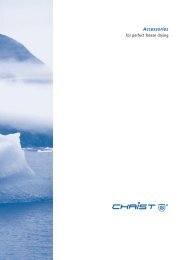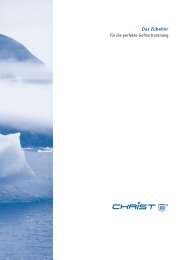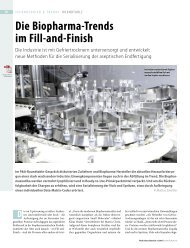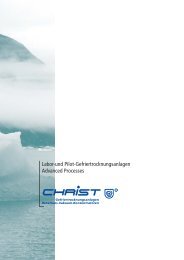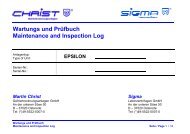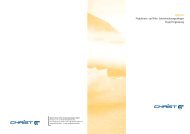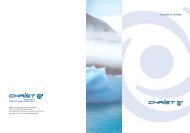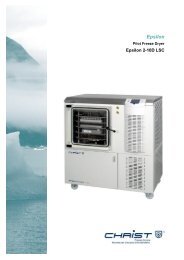SpeedDry Rotational Vacuum Concentrators - Martin Christ GmbH
SpeedDry Rotational Vacuum Concentrators - Martin Christ GmbH
SpeedDry Rotational Vacuum Concentrators - Martin Christ GmbH
Create successful ePaper yourself
Turn your PDF publications into a flip-book with our unique Google optimized e-Paper software.
<strong>SpeedDry</strong><br />
<strong>Rotational</strong> <strong>Vacuum</strong> <strong>Concentrators</strong>
2<br />
The Flexible Line of<br />
Products for Optimal Concentration
<strong>Rotational</strong> <strong>Vacuum</strong> <strong>Concentrators</strong>: Evaporation<br />
of Temperature Sensitive Samples with Care<br />
The Process<br />
This process is used for the evaporation, drying, purification<br />
and concentration of samples. This method is an alternative to<br />
the following processes:<br />
. Distillation systems and rotational evaporators use high<br />
temperatures and are working next to normal pressure.<br />
. Freeze-drying systems operate at very low temperatures<br />
and high vacuum levels. Although sublimation (the direct<br />
transformation from frozen solid to steam) protects the<br />
sample, it is time consuming.<br />
Rotation vacuum concentrators provide a method between<br />
the two above processes. The sample solvent evaporates at<br />
room temperature, at low pressure and without having to be<br />
frozen. This occurs relatively quickly. There is no thermal strain<br />
on the sample which is important when working with thermally<br />
sensitive biological or clinical substances. The material<br />
is rotated at a moderate centrifugal speed of 1.350 to 1.750<br />
min -1 . The resulting gravitational force prevents the product<br />
from spitting and bumping. The solvent is collected in traps<br />
and can be reused or discarded.<br />
The economically efficient <strong>Rotational</strong> <strong>Vacuum</strong><br />
Concentrator<br />
. no sample foaming, minimal sample loss<br />
. simultaneous, multiple sample drying<br />
. concentration of sample on tube bottom (other than in vortex-shaker),<br />
an advantage when using small volumes of thin<br />
solutions<br />
. suitable for drying of water and solvent-containing substances<br />
for volumes of less than 1 ml up to 3 liters<br />
. reproducible drying processes through control of process<br />
parameters such as rotor chamber temperature (energy<br />
input for evaporation) and vacuum (including the automatic<br />
setting of optimal pressure, depending on pump system)<br />
. safe and simple solvent recovery<br />
Possible uses<br />
. DNA/RNA (solvents mainly water, ethanol, methanol)<br />
. oligo-synthesis, peptides<br />
. PCR (polymer chain reaction)<br />
. HPLC (solvent mainly water/acetonitril)<br />
. isolation/synthesis of organic substances<br />
. storing and handling of substances (substance libraries)<br />
. combinational chemistry<br />
. high-throughput-screening (HTS)<br />
. analysis of food and environmental samples<br />
. toxicology, forensic<br />
. general laboratory evaporation<br />
vapour-pressure curve for H 2O vapour-pressure curves for commonly used organic solvents<br />
3
4<br />
<strong>SpeedDry</strong> <strong>Vacuum</strong> <strong>Concentrators</strong>:<br />
Performance that Speaks for itself<br />
. Magnetic drive with speed control: centrifugal force<br />
eliminates bumping and foaming, no rotating parts outside<br />
of the rotor-chamber, the chemicals remain within sample<br />
chamber.<br />
. Simple interface with the push of a button: Concentrator<br />
Display (CD) interface*, automatic sequence for start<br />
and stop, vacuum on and off depending on rotor speed,<br />
automatic aeration, sample is prevented from spitting.<br />
. Fast evaporation: high input of energy through electrical<br />
heating of rotor chamber, can be set in 1°C intervals from<br />
30°C to 80°C (except of RVC 2-18 = 60°C), cooling traps<br />
reduce evaporation time for larger sample volumes.<br />
. Useful for water or solvent containing samples:<br />
Basic Speed Dry systems with durable glass cover (is optional<br />
with the RVC 2-25), stainless steel rotor chamber, chemicaly<br />
resistant seals, anodized rotors. RVC 2-18 CD also<br />
available in HCL-resistant version.<br />
* for RVC 2-18 resp. CDplus for models RVC 2-25, 2-33 and 2-33 IR
Concentrator Display (CD) Interface<br />
. microprocessor system with LCD display<br />
. speed control<br />
. rotor chamber heating can be set in 1°C intervals<br />
from 30°C to 60°C (80°C)<br />
. pre-set time from 5 minutes to 12 hours<br />
. LC display shows important process and system<br />
parameters:<br />
- rotor temperature<br />
- time<br />
- open/close of cover<br />
- rotor speed<br />
- state of vacuum ("evacuated / aerated")<br />
- visual alarm with error code<br />
- optional data-interface<br />
additional with CDplus:<br />
- vacuum measurement and -control<br />
- ramp programming function for pressure and<br />
temperature<br />
- determination of the end of the drying process<br />
(pressure increase test) for automatic operation<br />
. No limits to your applications: system components can<br />
be individually combined, cooling traps range from 2-4<br />
liters and temperatures of -50/-60/-90 and -105°C, chemical<br />
resistant diaphragm vacuum pumps from 10 mbar to 2<br />
mbar final vacuum or chemical hybrid pumps with < 0.1<br />
mbar final vacuum (also for solvents with high boiling<br />
points).<br />
. Combination possibilities with your freeze-drying<br />
system: easy connection via rubber valve, especially suited<br />
for substances with high boiling points (e.g. DMSO, NMP)<br />
. Broadest range of rotors: from standard tubes to special<br />
flasks - our own rotor manufacturing covers almost every<br />
need.<br />
. Made in Germany: ISO 9001- certified series production,<br />
qualified technical and application service.<br />
5
6<br />
<strong>SpeedDry</strong> Product Range for <strong>Vacuum</strong> <strong>Concentrators</strong><br />
Basic Appliances in Three Different Sizes<br />
RVC 2-18 CD<br />
. the mini concentrator: inexpensive and compact table-top<br />
concentrator suited for smaller sample volumes<br />
. special DNA and HCL systems available<br />
. chemical resistant diaphragm pumps (2m3 /h suction capacity,<br />
7 mbar final vacuum), standard, vacuum system with<br />
lower vacuum and vacuum controls, optional<br />
. normally used without cooling traps<br />
System solutions for special processes<br />
The complete RVC 2-18 DNA system is designed for the concentration<br />
of DNA / RNA in ethanol/methanol / water solutions<br />
in up to 72 samples of 1.5 ml / 2.2 ml tubes. A special<br />
RVC 2-18 HCl (see photo left) version exists for material containing<br />
in hydrocloric acid. For other applications the systems<br />
can be configured according to need – please contact our<br />
application specialists for assistance.<br />
RVC 2-25 CDplus<br />
. the mid-size concentrator: all-purpose table-top concentrator<br />
for the routine concentration of larger sample volumes<br />
. rotor capacity 108 x 1.5/2.2 ml tubes up to 2 x microtiter<br />
plates<br />
. stainless steel/glass compound cover with window (corrosion<br />
proof, e.g. for DCM/ACN)<br />
. chemical resistant diaphragm pumps (2m3 /h suction,<br />
7 mbar final vacuum), standard, vacuum system with lower<br />
vacuum and vacuum controls, optional<br />
. optional combination with cooling traps (2 or 4 Liters) for<br />
increased evaporation
RVC 2-33 CDplus<br />
. The maxi concentrator: a multipurpose system for large<br />
sample volumes with practically all types of solvents<br />
. rotor capacity 216 x 1.5/2.2 ml tubes up to 12 x microtiter<br />
plates or 4 x deep-well plates<br />
. stainless steel/glass compound cover with window (corrosion<br />
proof)<br />
. high-performance drive system, 1.550 min-1 (500xg f. micro<br />
tubes) prevents bumping and foaming (e.g. with DCM)<br />
. practically tolerant to imbalance (> 50 g)<br />
. c hemical resistant diaphragm pumps (2m3 /h suction,<br />
9 mbar final vacuum), standard, vacuum system with lower<br />
vacuum and vacuum controls, optional, chemical hybridpump<br />
for solvents with high boiling points (e.g. DMSO)<br />
. recommended use with 4 liter cooling traps due to high<br />
volume evaporation (-50°C, -60°C, -90°C or -105°C)<br />
. flexible use as vacuum drying chamber through easy dismantling<br />
of rotor shaft<br />
<strong>Rotational</strong>-<strong>Vacuum</strong>-Concentrator <strong>SpeedDry</strong> 2-33IR<br />
Fastest possible Sample Concentration and Drying<br />
This newly developed CHRIST-vacuum concentrator <strong>SpeedDry</strong><br />
2-33IR is particularly suitable for gentle concentration of<br />
DNA/RNA, proteins and similar analysis preparations at the<br />
workplace. The versatile rotor program provides a high sample<br />
capacity, e.g. from 216 x 1.5 ml reaction vials up to 12 x<br />
microtiter-plates or 4 x deep-well-plates. In addition, large<br />
sample volumes, e.g. 100-ml-tubes that are used for the<br />
screening of active substances can be quickly concentrated<br />
thanks to the efficient energy supply with halogen IR lamps.<br />
The innovative drive system with its powerful external rotor<br />
motor, the contact-free, central rotary coupler, and direct<br />
power transmission all guarantee safe operation even in the<br />
event of high unbalance. The user-friendly CDplus control unit<br />
provides a quick overview of the current operating parameters.<br />
Heating temperatures between +30 °C and +80 °C and,<br />
of course, also the entire pressure range of the vacuum pump<br />
can be selected either manually or controlled by a program,<br />
also freeze drying possible.<br />
7
8<br />
Features<br />
More Choice for the Job at Hand-<br />
the RVC-Module System Adapts to Your Needs<br />
· Particularly solvent-resistant unit with a stainless steel<br />
chamber, safety glass lid and magnetic drive without a shaft<br />
exit to the outside. Suitable for DMSO, ACN, TFA.<br />
· CDplus control unit with a ramp programming function for<br />
pressure and temperature (16 programs max.).<br />
· Halogen IR lamps provide optimal energy input for fastest<br />
possible evaporation.<br />
· Control of the energy supply as a function of the sample<br />
vessel temperature, plus an additional measurement of the<br />
product temperature in order to avoid thermal damage.<br />
· Robust, non-contact measurement data transfer (Triple<br />
TMM) from the rotor to the control unit.<br />
· Precise vacuum control in both directions (air injection) for<br />
reproducible processes. High-performance vacuum pumps<br />
with final vacuum of
Rotor-Table RVC<br />
Nominal Tube RVC 2-18 RVC 2-18 HCI RVC 2-25 RVC 2-33 RVC 2-33 IR<br />
tube size CD CD CDplus CDplus CDplus<br />
volume (ml) diameter x length (mm)<br />
0.2 6 x 20 3 x 72<br />
0.25 / 0.5 5.8 x 47 2 x 40 2 x 40<br />
0.6 6 x 38<br />
0.5 / 0.75 7.9 x 28 3 x 30 3 x 48<br />
1 5 x 100 18 48 72 72<br />
1 7.2 x 40 3 x 36<br />
1.5 / 2.0 10.8 x 38 3 x 24 2 x 24 3 x 36 3 x 72 3 x 72<br />
1.5 11–12 x 31–39 3 x 54 3 x 48<br />
2 8 x 90 24<br />
2 10.7 x 72 12<br />
2 11.2 x 36 3 x 36 3 x 36<br />
2 12 x 36 3 x 36<br />
2 12.3 x 42 2 x 36<br />
2 16.1 x 56 2 x 18<br />
2.5 11.7 x 32 3 x 24 2 x 36<br />
2.5 12 x 36 3 x 24 2 x 24<br />
4 14.8 x 83 12<br />
4 12.7. x 46 2 x 36<br />
5 15 x 45 2 x 18 2 x 18 2 x 30<br />
5 15 x 50 2 x 72<br />
5.5 15.6 x 57 2 x 18<br />
5 16.5 x 35 3 x 24<br />
5 16.7 x 50.3–65 3 x 36 3 x 36<br />
4 / 7 12.5 x 75–85 48 72<br />
4 / 7 12.5 x 70–100 18 18<br />
8 /10 12–13 x 100–120 18 36 54 2 x 72<br />
10 16–17 x 65–100 2 x 48<br />
10 16 x 150 8<br />
10 20 x 62 12<br />
13 15.2 x 100 36 48<br />
10 / 15 16.5 x 80–100 12 12 24 48 48<br />
15 / 18 16.5 x 100–125 Falcon 6 6 24 48 48<br />
15 18 x 100 36 48 48<br />
15 18 x 120 27 48 48<br />
16 19.1 x 107 12<br />
15 19 x 80–125 2 x 24<br />
18 20 x 70–80 18<br />
20 / 25 18–19.5 x 110–140 36<br />
20 15.6–16.5 x 104–162 48<br />
30 18 x 180 24 24<br />
30 24–25 x 105–120 8 12 18 36<br />
30 20–21.5 x 150–180 24 24<br />
50 24–24.5 x 120–160 24<br />
50 24–25 x 105–166 24<br />
50 27–29 x 100–120 Falcon 18<br />
50 27 x 140 20<br />
50 28.5 x 107 6 6<br />
50 29.5 x 117 6 6 8 18 24<br />
50 34 x 100 6 8 12 12<br />
50 / 80 28–30 x 120–150 24<br />
70 24–25 x 144–203 20<br />
70 44–45 x 120–140 12<br />
100 45 x 100–120 6 8 / 12 12<br />
340 56 x 200 flasks 6<br />
500 105 x 175 flasks 6<br />
MT-plate 86 x 128 x 20 2 4 x 3 4 x 3<br />
DW-plate 86 x 128 x 40 2 4 4<br />
9
10<br />
Chemical Resistant Diaphragm <strong>Vacuum</strong> Pumps / Hybrid <strong>Vacuum</strong> Pumps<br />
Chemical Resistant Diaphragm <strong>Vacuum</strong> Pumps /<br />
Hybrid <strong>Vacuum</strong> Pumps<br />
Chemical membrane pumps are mechanical, oil free vacuum<br />
pumps. Final vacuum values of up to 2 mbar can be achieved<br />
depending on the type of pump used. They are particularly<br />
useful for solvents with low to medium level boiling points.<br />
The parts that come into contact with the substance are made<br />
of corrosion resistant materials and are resistant to chemically<br />
aggressive vapors and condensation. VARIO chemical pumping<br />
units allow for the automatic adjustment of the optimal<br />
working pressure for high evaporation rates.<br />
The RC-6 chemical hybrid pump is the corrosion-proof combination<br />
of a two-staged rotary pump and a chemical resistant<br />
membrane pump. The end vacuum of up to 2 x 10 -3 mbar<br />
makes this pump suitable for solvents with high boiling<br />
points.<br />
Features<br />
. high chemical resistance (parts in contact with samples<br />
made of PTFE compounds), continious oil cleaning within<br />
the chemically resistant hybride pump RC-6<br />
. high suction performance, even at low values<br />
. gas-ballast valve avoids condensing inside the pump<br />
. virtually 100% solvent recovery with emission condenser<br />
. self-finding working pressure in VARIO models, reducing<br />
process-time by 30%<br />
. runs quietly, compact form<br />
MZ 2C NT MD 4C NT PC 3001 Vario RC-6<br />
suction power (m 3 /h) 2.0 3.4 1.7 6<br />
final vacuum (mbar) 7 1.5 2 2 x 10 -3<br />
special features . with or without . with emissions . with emissions . with or without<br />
emissions condenser condenser condenser emissions condenser<br />
(solvent-recovery vessel) . vacuum control . vacuum control . low end vacuum level<br />
. automatic mode: self- . automatic mode: self suitable for solvents<br />
adapting vacuum for adapting vacuum for with high boiling point<br />
shorter process times shorter process times (DMSO, NMP, DMF)<br />
. low end vacuum level . low end vacuum level . connection with cooling<br />
suitable for solvents suitable for solvents trap recommended<br />
with high boiling point with high boiling point
Cooling Traps for Larger Volumes<br />
The rate of evaporation is not only influenced by the energy<br />
input, but also by the suction capacity of the diaphragm<br />
pump. It is significantly more efficient to use a cooling trap<br />
(cryo-pump), instead of bigger vacuum pumps. Processes<br />
involving water solutions benefit from cooling traps, organic<br />
solutions are less critical due to their higher vapour density.<br />
The larger evaporation area surface sample is what causes<br />
the "bottle-neck" in the pump, not the volume and number of<br />
the vials.<br />
CT02-50 and CT 04-50<br />
. 2 liters volume (CT02-50), 4 liters (CT04-50)<br />
. condenser temperature -50°C<br />
. easy solvent release drain valve<br />
. LED display shows condenser temperature<br />
. vacuum concentrator connection with chemical-resistant<br />
glass cover<br />
Alpha 1-2 LD, Alpha 2-4 LD and Beta 2-4 LT<br />
. volume 2 liters (Alpha 1-2 LD), 4 liters (Alpha 2-4 LD and<br />
Beta 2-4 LT)<br />
. condenser temperature -60°C (Alpha 1-2 LD), -90°C (Alpha<br />
2-4 LD), -105°C (Beta 2-4 LT)<br />
. powerful ice condenser with internal condenser coils<br />
. Lyo-Display (LD) system interface showing ice condenser<br />
temperature, vacuum display optional<br />
. vacuum concentrator connection with chemical-resistant<br />
glass cover<br />
. optional RS 232 data interface<br />
. expandable into freeze-drying system<br />
connection to freeze-drying system<br />
. for example: connection to Alpha systems (with LD or LSC<br />
interface) please see separate product information<br />
. directly connected to the drying chamber of the freeze dryer<br />
with a rubber valve<br />
11
12<br />
Examples for Evaporation Times<br />
Evaporation time is dependent on the type of solvent used.<br />
As a rule, solvents with a low boiling point (i.e. DCM methylenchloride,<br />
chloroform, methanol, hexane) evaporate more<br />
easily and quickly than solvents with high boiling points<br />
(i.e. water, DMF, DMSO, NMP). Examples are shown in the<br />
table below.<br />
The energy input into the product through the heating of the<br />
rotor chamber also influences evaporation. Evaporation time<br />
is reduced through this source, particularly in solvents with<br />
high boiling points (also water-based substances). The remaining<br />
product stays cool as the solvent's temperature remains<br />
low through evaporation.<br />
Influence of energy input on<br />
evaporation times<br />
The energy input to the sample is essential for the duration of<br />
the evaporation process. With standard vacuum-concentrators<br />
electrical heating of the rotor chamber is used while with the<br />
special High-Throughput-System <strong>SpeedDry</strong> 2-33IR IR-lamps<br />
provide a direct energy input to the samples. Results are reduced<br />
evaporation times – depending on used solvent up to factor<br />
2-4 faster. The following figures show examples for different<br />
solvents.<br />
System configuration: <strong>SpeedDry</strong> RVCV 2-33 Standard (with<br />
electrical heating of the rotor chamber) and RVC 2-33IR (with<br />
improved IR-heating), sample volumes 12 x 50 ml, p=10<br />
mbar, with cold trap -50°C.<br />
Evaporation times<br />
RVC 2-18 / 2-25<br />
v = 48 x 1,5 ml<br />
T = 50°C<br />
p = 10-20 mbar
Used for following solvents: solvents low to middle solvents high boiling special RVC 2-18 system<br />
boiling points points (in conjunction with<br />
vacuum pumps and cooling traps)<br />
. acetronitril (ACN) . dimethylsulfoxide . hydrochloric acid (HCl)<br />
. acetone (DMSO)<br />
. chloroform<br />
. NMP<br />
. dioxin<br />
. dioxane<br />
. methylenchloride (DCM)<br />
. ethanol (EtOH)<br />
. hexane (Hex)<br />
. methanol (MeOH)<br />
. TFA<br />
. water<br />
. t-butanol<br />
13
14<br />
Technical Data<br />
RVC 2-18 CD RVC 2-25 CDplus RVC 2-33 CDplus RVC 2-33 IR CDplus<br />
Rotor speed (min –1 ) 1500 1550 1550 1750<br />
(adjustable with controller CDplus)<br />
Relative centrifugal force (rcf) 210 235 500 530<br />
max. allowed imbalance (g) 20 30 50 50<br />
Temperatur range (°C) + 30 bis + 60 + 30 bis + 80 + 30 bis + 80 + 30 bis + 80<br />
Process vacuum depending on pump < 0,1 < 0,1 < 0,1 < 0,1<br />
system, max. (mbar)<br />
Dimensions 240 x 240 x 325 315 x 255 x 460 390 x 315 x 406 390 x 315 x 406<br />
(mm, w x h x d)<br />
Weight (kg) 14 24 44 48.5<br />
Electrical connection (V/Hz) 230/50–60 230/50–60 230/50–60 230/50-60<br />
(other voltages available)<br />
Max. power consumption (kVA)<br />
0.5 0.9 1.4 1.4<br />
Max. current (A) 2 3.5 5.8 5.8<br />
Max. ambient temperature,<br />
climate category SN (°C) + 10 bis + 25 + 10 bis + 25 + 10 bis + 25 + 10 bis + 25<br />
(higher temperatures upon request)<br />
Sound emission acc. to DIN 45635 (dB/A) 40 44 49 49<br />
<strong>Vacuum</strong> connection, small flange DN 16 KF DN 16 KF DN 25 KF DN 25 KF<br />
Suggested vacuum pumps MZ 2C MZ 2C MZ 2C MZ 2C<br />
(other combinations possible) MD 4C MD 4C MD 4C MD 4C<br />
PC 3001 Vario PC 3001 Vario PC 3001 Vario PC 3001 Vario<br />
RC-6 RC-6 RC-6<br />
suggested cooling traps CT 02-50 CT 02/04-50 CT 04-50 CT 04-50<br />
(other combinations possible) directly to ALPHA 1-2 / 2-4 ALPHA 2-4 ALPHA 2-4<br />
freeze dryer Beta 2-4 LT<br />
directly to<br />
Beta 2-4 LT Beta 2-4 LT<br />
please note: cooling traps are not absolutely<br />
necessary when using chemical resistant<br />
diaphragm pumps, but are recommended<br />
with samples > 100 ml in order to decrease<br />
evaporation time<br />
freeze dryer<br />
We reserve the right to make technical changes without prior notice
Product Spectrum<br />
Our comprehensive product range of freeze dryers and vacuum<br />
concentrators for every application. Do not hesitate to<br />
contact us for an individual configuration of your system.<br />
Freeze dryers for industrial production<br />
Pilot systems for process development and optimization<br />
Freeze dryers for research and development<br />
<strong>Rotational</strong> vacuum concentrators, available in different<br />
sizes, covering the gamut from solving routine laboratory<br />
problems to the evaporation in high-end pharmaceutical<br />
research<br />
Freeze dryers for routine laboratory use<br />
15
<strong>Martin</strong> <strong>Christ</strong> Gefriertrocknungsanlagen <strong>GmbH</strong><br />
P.O.B. 17 13 . D-37507 Osterode am Harz<br />
Tel. +49 (0) 55 22/50 07-0 . Fax +49 (0) 55 22/50 07-12<br />
www.martinchrist.de e-mail: info@martinchrist.de



